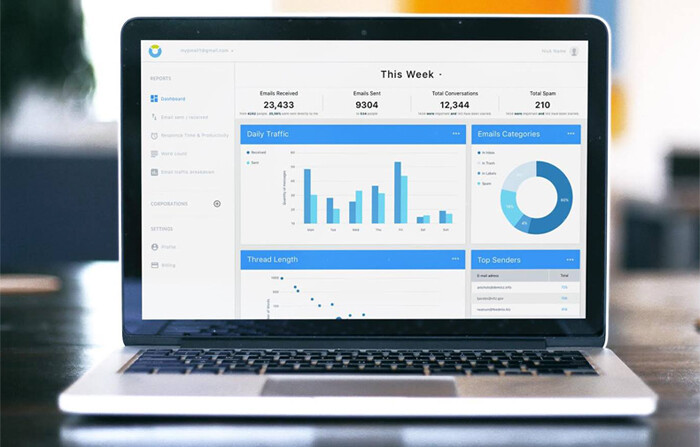Data analytics has helped SMEs optimize their business models in countless ways. One of the biggest ways that big data is helping them is by making it easier for them to monitor email communications.
Data Analytics Paves the Way for More Effective Email Monitoring
Big data is changing the nature of digital communications in ways that we have never seen. There is probably no better example than in the realm of email. As a manager, it pays to know what your employees are doing throughout the week. While you don?t need to be hovering over their shoulders, or micromanaging every decision they make, you should know, high-level, how productive they are, how efficient they are, and how they?re emailing on an ongoing basis. You can use big data to track performance of your email communications in countless ways. Email monitoring software tools can help you identify and proactively fix pain points, while also helping you determine the effectiveness of your overall strategies. The question is, which email monitoring software tools should you be using?
What Email Monitoring Software Tools Can Tell You
These are some of the high-level points to look for when using email monitoring software use sophisticated data capabilities to track employee email activity:
- Workloads. In an ideal team, everyone will share the responsibilities and workload evenly. In reality, teams often end up lopsided, with some employees doing more work than others. Email monitoring software uses data analytics to help you measure relative workloads; busier employees will likely be sending and receiving emails more frequently. From there, you can rebalance workloads to be more appropriate.
- Schedules. Email monitoring software tools also enable you to get a feel for employee schedules. Inevitably, some times of day and days of the week will be busier than others?so what are your employees doing during the non-busy periods? This is useful information, both for optimizing employee scheduling and for making determinations about their overall productivity. They also have a lot of data analytics systems built in, which can offer insightful recommendations.
- Success rates. Salespeople find prospecting to be the most difficult part of the job, and it?s no wonder why. Reaching out to new leads via email is challenging. Email monitoring software can help you analyze the emails your sales team sends out, including how the conversations manifest, and which tactics seem to work best.
- Bad habits. Email monitoring software can expose some bad habits that might otherwise compromise your employees? productivity or effectiveness. For example, you might discover that one employee has a penchant for creating long, seemingly never-ending email threads, or that another one uses their work email account for personal emails.
- Strengths and weaknesses. Every employee on your team will have strengths and weaknesses when it comes to email, and email monitoring can help you figure those out, and work to compensate for them.
The Best Email Monitoring Software Tools
So which email monitoring software tools are best? These are the top standouts:
1. EmailAnalytics
is an email monitoring tool designed for Gmail, and it offers comprehensive statistics on all your employees? email habits. You?ll learn how many emails they send and receive, their busiest times and days, how they start and manage email threads, how much time they spend writing and reading emails, and more. Even better, these data points are packaged into interactive visuals, which you can use to measure employees? progress over time, or demonstrate the manifestation of a particular bad habit. Think of it as Google Analytics for Gmail.
2. MyAnalytics
, by contrast, is designed for Outlook, and the rest of the tools you?ll get with Office 365. Rather than digging into messaging habits specifically, MyAnalytics attempts to measure how employees are spending their time across various platforms and throughout the day. By looking at data from emails, employee calendars, and other apps, it displays a breakdown of how each employee?s hours are spent throughout the week. It?s handy for determining whether you?re wasting too much time in unnecessary meetings, and just how much time they spend on Outlook.
3. Yesware.
There?s also Yesware, which is designed to integrate with SalesForce. This tool is mostly intended for sales teams, since it measures email metrics like open rates, reply rates, internal link clicks, and attachment opens, but it could also be used to track the performance of each of your salespeople. You?ll also be able to automatically log these data in SalesForce, so your entire team can access them, and work autonomously to improve themselves. EmailAnalytics is the most robust tool specifically designed for email monitoring, but each of these platforms is optimized for a different application. Choose the one that suits your business (and the tools you?re currently using) best. To use these email monitoring software tools effectively, you?ll need a system for giving feedback to your employees. Inevitably, you?ll find at least one employee with a bad habit or a problematic approach that needs to be corrected. Being proactive, polite, and direct with your feedback will help your employees accept it; just make sure to follow up after a few weeks to ensure your points of concern are being addressed.
Big Data Brings Email Monitoring into the 21st Century
Email monitoring technology hadn?t changed much since the early days of email. However, big data is changing this in ways that we wouldn?t have foreseen 20 years ago. This is a major development that all managers need to be aware of.
